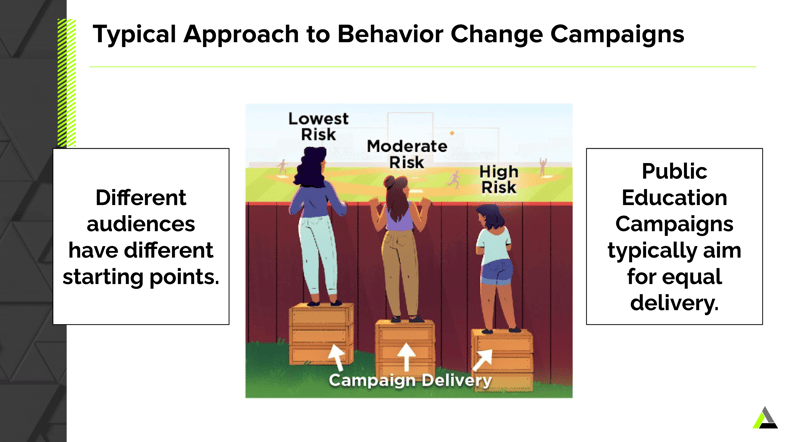New Digital Learning Opportunities
Discover upcoming behavior change webinars rescueagency.com/webinars
When creating public health campaigns, it’s more important than ever to focus on making programs that efficiently reach those who need our help the most. Programs often put too much emphasis on trying to reach everyone. In this article, we’ll explain why programs that are intended to "reach everyone" aren't effective and provide some strategies for creating truly impactful public health campaigns.
Each of our audiences is impacted differently by environmental and personal circumstances, and programs that focus on equality over needs-based impact tend to over-deliver to lower-risk audiences and under-deliver to higher-risk audiences. In the graphic below, the grass represents environmental circumstances and the heights of the women represent personal circumstances. The little boxes underneath them represent our programs and investments in people.

READ MORE: Learn how our internal team of PhDs and MPHs use research to better understand the needs of our audiences.
When we try to create messages that “speak to everybody,” we're producing “lowest common denominator creative,” trying to find the simplest message that everyone can hear and understand so no one feels left out. The problem is those who have the means, time and resources—represented by the lady on the left in the graphic below—can take advantage of that simple message. Audiences with more obstacles and challenges, like the lady depicted on the right, need more support to take advantage of that message.
Even the media channels used to disseminate our messages disproportionately cater to lower-risk individuals. The vast majority of media channels have been structured to reach those who are in purchasing audiences, which are most often the lower-risk individuals. We end up with disproportionate distribution and impact, which widens disparities, as seen in the graphic below.

READ MORE: Learn how we helped increase quitline enrollments among priority populations.
For a program to actually be effective, we have to strive for needs-based impact throughout research, strategy, message development, and implementation prioritizing those at greatest risk and understanding their challenges. This approach ends up benefiting everyone. Messages that show a higher-risk person overcoming their adversity can help empower lower-risk audiences, as well. They see someone with more barriers than them engaging in healthy behavior and realize the behavior is attainable for them, too.
Media also must be disproportionately delivered to those at greatest risk. We have to work against algorithms designed to deliver messages to lower-risk audiences who are already interested in the message. We need to ensure that those who need the message most get a higher dosage of it. Only when we intentionally infuse needs-based impact into every phase of our campaign development can we truly ensure that our program is impactful.

If you’d like to learn more about creating needs-based campaigns, please contact us.
RESCUE HEADQUARTERS: 2437 Morena Blvd San Diego, CA 92110 - (619) 231-7555 - Privacy Policy
Copyright © 2026 Rescue Agency, Public Benefit LLC. All Rights Reserved. Social Branding ® and Evolvement ® are registered trademarks.
Join our email list to learn new strategies for improving the health of your community. Please complete the form below to opt in to receive emails from Rescue Agency.
* indicates required